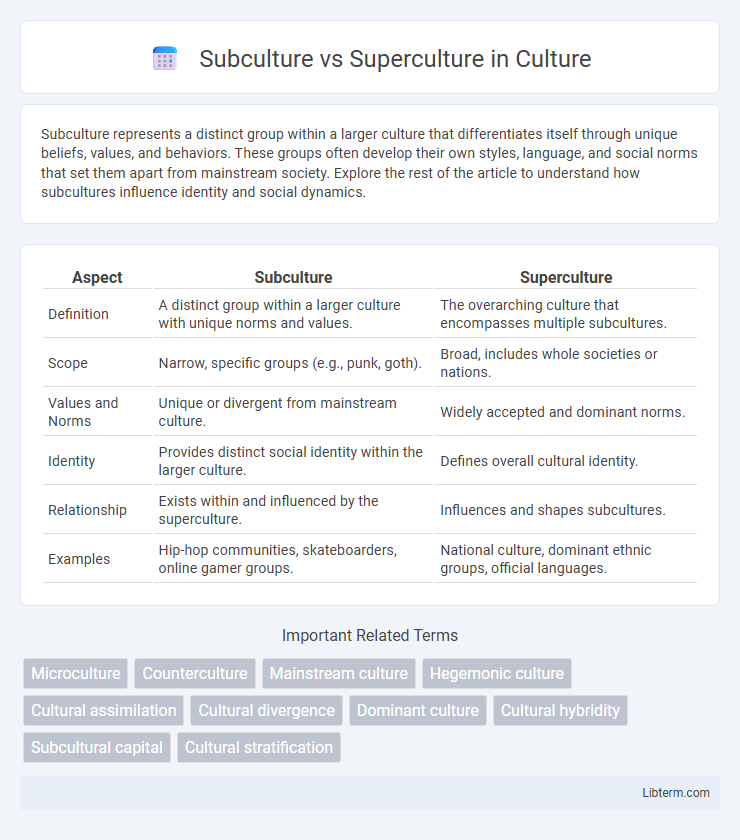Subculture represents a distinct group within a larger culture that differentiates itself through unique beliefs, values, and behaviors. These groups often develop their own styles, language, and social norms that set them apart from mainstream society. Explore the rest of the article to understand how subcultures influence identity and social dynamics.
Table of Comparison
| Aspect | Subculture | Superculture |
|---|---|---|
| Definition | A distinct group within a larger culture with unique norms and values. | The overarching culture that encompasses multiple subcultures. |
| Scope | Narrow, specific groups (e.g., punk, goth). | Broad, includes whole societies or nations. |
| Values and Norms | Unique or divergent from mainstream culture. | Widely accepted and dominant norms. |
| Identity | Provides distinct social identity within the larger culture. | Defines overall cultural identity. |
| Relationship | Exists within and influenced by the superculture. | Influences and shapes subcultures. |
| Examples | Hip-hop communities, skateboarders, online gamer groups. | National culture, dominant ethnic groups, official languages. |
Defining Subculture and Superculture
Subculture represents a distinct group within a larger culture, characterized by unique values, norms, behaviors, and symbols that differentiate its members from the dominant cultural group. Superculture refers to an overarching cultural framework that encompasses and integrates various subcultures while maintaining a cohesive set of shared beliefs and practices. Defining subculture involves identifying the specific traits, social patterns, and collective identity that distinguish its members, whereas defining superculture emphasizes the common cultural elements that unify diverse subgroups within a broader societal context.
Historical Evolution of Subcultures
The historical evolution of subcultures reveals diverse social groups emerging as responses to dominant cultural norms, often originating in industrial societies during the late 19th and 20th centuries. Key examples include the punk movement of the 1970s, which challenged mainstream values through music and fashion, and the Beat Generation of the 1950s, which opposed post-war conformity through literature and lifestyle. These subcultures play crucial roles in shaping identity, resistance, and innovation within broader supercultures over time.
Origins and Development of Supercultures
Supercultures originate from the fusion of multiple subcultures, emerging through processes of cultural integration driven by globalization, technological advancements, and shared economic or political interests. The development of supercultures involves the creation of overarching norms, values, and practices that transcend individual subcultural identities, fostering a collective cultural framework on regional, national, or global scales. These supercultures evolve as adaptive systems, continuously influenced by intercultural exchange, mass media, and institutional structures that reinforce their dominance and cohesion.
Key Characteristics of Subcultures
Subcultures exhibit distinct key characteristics such as unique values, norms, language, and styles that differentiate them from the dominant superculture. These groups often form around shared interests, beliefs, or lifestyles, fostering a sense of identity and community among members. Subcultures may challenge mainstream cultural practices and offer alternative perspectives within the broader societal context.
Major Traits of Supercultures
Supercultures exhibit major traits such as widespread influence across diverse populations, integration of multiple subcultures, and a unifying set of values, norms, and practices that transcend regional and social boundaries. They promote shared language, ideologies, and institutions that facilitate cohesion and collective identity on a large scale. These dominant cultural frameworks often drive societal evolution by fostering communication, cooperation, and innovation across heterogeneous groups.
Interaction Between Subculture and Superculture
The interaction between subculture and superculture involves a dynamic exchange where subcultures influence and reshape elements of the dominant superculture, while the superculture provides a shared framework of norms and values. Subcultures often challenge mainstream ideologies, introducing alternative lifestyles, languages, or artistic expressions that can gradually be absorbed into the superculture. This continuous interplay drives social evolution by blending diversity with collective identity, fostering both cultural innovation and social cohesion.
Influence of Subculture on Society
Subcultures shape society by introducing unique values, behaviors, and styles that challenge mainstream norms and encourage cultural diversity. They influence social trends, language, fashion, and art, often driving innovation and progressive change within the larger culture. The dynamic interaction between subcultures and the dominant society leads to continual cultural evolution and adaptation.
Superculture’s Impact on Identity and Values
Superculture shapes collective identity by embedding dominant values, norms, and symbols that influence individual and group behavior within a society. It acts as a unifying framework, providing shared cultural references that guide social interactions and establish mainstream beliefs. The pervasive influence of superculture often marginalizes subcultural identities, leading to either assimilation or resistance as groups negotiate their distinct values against dominant cultural norms.
Conflict and Harmony: Subculture vs Superculture
Subcultures often generate conflict with the dominant superculture by challenging established norms, values, and social practices, leading to tensions and social resistance. However, harmony can emerge when subcultures influence the superculture, resulting in the adaptation or incorporation of new ideas, trends, and innovations that enrich the broader society. The dynamic interplay between subculture and superculture shapes cultural evolution through continuous negotiation and mutual influence.
Future Trends in Cultural Dynamics
Future trends in cultural dynamics show subcultures increasingly influencing mainstream supercultures through digital platforms and globalization, fostering hybrid identities and cross-cultural exchanges. Advances in technology enable subcultures to gain visibility and accelerate the diffusion of niche practices into broader societal norms. The interplay between subcultures and supercultures drives adaptive cultural evolution, reshaping values, behaviors, and social structures in the globalized world.
Subculture Infographic

 libterm.com
libterm.com